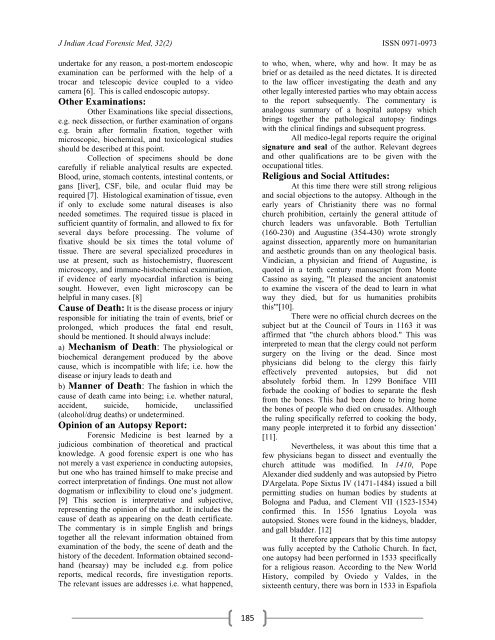jiafm, 2010-32(2) april-june. - forensic medicine
jiafm, 2010-32(2) april-june. - forensic medicine
jiafm, 2010-32(2) april-june. - forensic medicine
- No tags were found...
Create successful ePaper yourself
Turn your PDF publications into a flip-book with our unique Google optimized e-Paper software.
J Indian Acad Forensic Med, <strong>32</strong>(2) ISSN 0971-0973undertake for any reason, a post-mortem endoscopicexamination can be performed with the help of atrocar and telescopic device coupled to a videocamera [6]. This is called endoscopic autopsy.Other Examinations:Other Examinations like special dissections,e.g. neck dissection, or further examination of organse.g. brain after formalin fixation, together withmicroscopic, biochemical, and toxicological studiesshould be described at this point.Collection of specimens should be donecarefully if reliable analytical results are expected.Blood, urine, stomach contents, intestinal contents, organs [liver], CSF, bile, and ocular fluid may berequired [7]. Histological examination of tissue, evenif only to exclude some natural diseases is alsoneeded sometimes. The required tissue is placed insufficient quantity of formalin, and allowed to fix forseveral days before processing. The volume offixative should be six times the total volume oftissue. There are several specialized procedures inuse at present, such as histochemistry, fluorescentmicroscopy, and immune-histochemical examination,if evidence of early myocardial infarction is beingsought. However, even light microscopy can behelpful in many cases. [8]Cause of Death: It is the disease process or injuryresponsible for initiating the train of events, brief orprolonged, which produces the fatal end result,should be mentioned. It should always include:a) Mechanism of Death: The physiological orbiochemical derangement produced by the abovecause, which is incompatible with life; i.e. how thedisease or injury leads to death andb) Manner of Death: The fashion in which thecause of death came into being; i.e. whether natural,accident, suicide, homicide, unclassified(alcohol/drug deaths) or undetermined.Opinion of an Autopsy Report:Forensic Medicine is best learned by ajudicious combination of theoretical and practicalknowledge. A good <strong>forensic</strong> expert is one who hasnot merely a vast experience in conducting autopsies,but one who has trained himself to make precise andcorrect interpretation of findings. One must not allowdogmatism or inflexibility to cloud one‟s judgment.[9] This section is interpretative and subjective,representing the opinion of the author. It includes thecause of death as appearing on the death certificate.The commentary is in simple English and bringstogether all the relevant information obtained fromexamination of the body, the scene of death and thehistory of the decedent. Information obtained secondhand(hearsay) may be included e.g. from policereports, medical records, fire investigation reports.The relevant issues are addresses i.e. what happened,to who, when, where, why and how. It may be asbrief or as detailed as the need dictates. It is directedto the law officer investigating the death and anyother legally interested parties who may obtain accessto the report subsequently. The commentary isanalogous summary of a hospital autopsy whichbrings together the pathological autopsy findingswith the clinical findings and subsequent progress.All medico-legal reports require the originalsignature and seal of the author. Relevant degreesand other qualifications are to be given with theoccupational titles.Religious and Social Attitudes:At this time there were still strong religiousand social objections to the autopsy. Although in theearly years of Christianity there was no formalchurch prohibition, certainly the general attitude ofchurch leaders was unfavorable. Both Tertullian(160-230) and Augustine (354-430) wrote stronglyagainst dissection, apparently more on humanitarianand aesthetic grounds than on any theological basis.Vindician, a physician and friend of Augustine, isquoted in a tenth century manuscript from MonteCassino as saying, "It pleased the ancient anatomistto examine the viscera of the dead to learn in whatway they died, but for us humanities prohibitsthis"'[10].There were no official church decrees on thesubject but at the Council of Tours in 1163 it wasaffirmed that "the church abhors blood." This wasinterpreted to mean that the clergy could not performsurgery on the living or the dead. Since mostphysicians did belong to the clergy this fairlyeffectively prevented autopsies, but did notabsolutely forbid them. In 1299 Boniface VIIIforbade the cooking of bodies to separate the fleshfrom the bones. This had been done to bring homethe bones of people who died on crusades. Althoughthe ruling specifically referred to cooking the body,many people interpreted it to forbid any dissection‟[11].Nevertheless, it was about this time that afew physicians began to dissect and eventually thechurch attitude was modified. In 1410, PopeAlexander died suddenly and was autopsied by PietroD'Argelata. Pope Sixtus IV (1471-1484) issued a billpermitting studies on human bodies by students atBologna and Padua, and Clement VII (1523-1534)confirmed this. In 1556 Ignatius Loyola wasautopsied. Stones were found in the kidneys, bladder,and gall bladder. [12]It therefore appears that by this time autopsywas fully accepted by the Catholic Church. In fact,one autopsy had been performed in 1533 specificallyfor a religious reason. According to the New WorldHistory, compiled by Oviedo y Valdes, in thesixteenth century, there was born in 1533 in Espafiola185



![syllabus in forensic medicine for m.b.b.s. students in india [pdf]](https://img.yumpu.com/48405011/1/190x245/syllabus-in-forensic-medicine-for-mbbs-students-in-india-pdf.jpg?quality=85)



![SPOTTING IN FORENSIC MEDICINE [pdf]](https://img.yumpu.com/45856557/1/190x245/spotting-in-forensic-medicine-pdf.jpg?quality=85)

![JAFM-33-2, April-June, 2011 [PDF] - forensic medicine](https://img.yumpu.com/43461356/1/190x245/jafm-33-2-april-june-2011-pdf-forensic-medicine.jpg?quality=85)



![JIAFM-33-4, October-December, 2011 [PDF] - forensic medicine](https://img.yumpu.com/31013278/1/190x245/jiafm-33-4-october-december-2011-pdf-forensic-medicine.jpg?quality=85)


